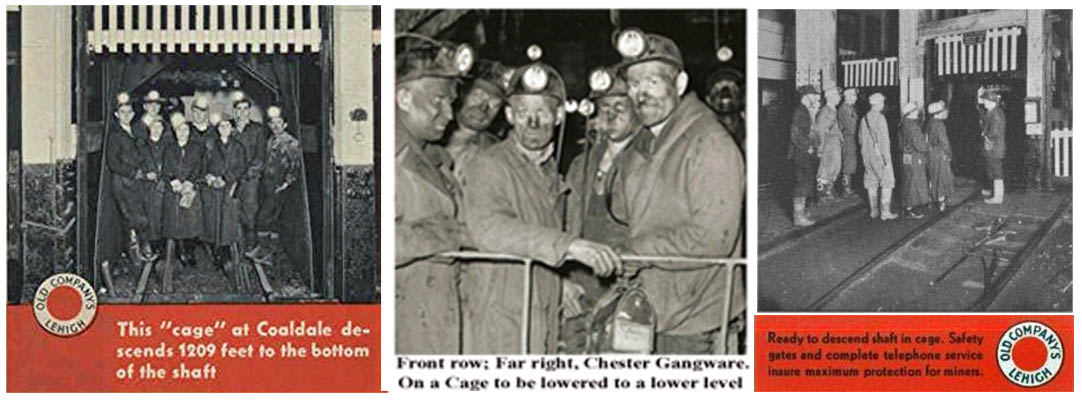EXCERPTS:
Even mine vehicles such as the cage – an elevator-type device used to transport miners to and from the surface and considered a safety net for miners in case of emergency – could themselves be danger traps.
Six weeks after the first cage accident at the No. 4 Colliery in Lansford and just a week before Christmas (in 1910), there was yet another shaft tragedy involving a cage at the No. 10 colliery in Coaldale. When the engineer started to lower the cage it refused to move because it had frozen to the side.
About 30 feet of cable had unwound. Before he could take up the slack the ice in the shaft broke away, sending the cage plunging down the shaft. Fortunately the cable did not break but the awful jar at the end of the cable tossed the miners to the floor of the cage with such force that many suffered broken bones.
Injured were George Welsh, 29, a laborer from Coaldale, broken back; William Tucket, 30, laborer, back injury; Bernard O'Donnell, Coaldale, 25, miner, back injury and broken ribs; Benjamin Welsh, Coaldale, 25, miner, broken leg; John Fisher, Seek, 27, driver boss, spine injury; and David Yemm, Coaldale, 35, mine foreman, fractured legs and spine injury.
FULL ARTICLE:
Even mine vehicles such as the cage – an elevator-type device used to transport miners to and from the surface and considered a safety net for miners in case of emergency – could themselves be danger traps.
In early November 1910, 10 miners had boarded their cage at the No. 4 colliery near Lansford for their usual descent on the 7 a.m. shift.
At about 200 feet, they noticed the cage was traveling unusually fast. It was in fact in freefall, dropping 500 feet in seconds before crashing. According to the Tamaqua Courier, the cage struck the platform at the bottom of the shaft, which covered about 45 feet of water, with "a terrible crash.”
"Had the cage gone through this (platform), which seems a miracle it did not, they all would have been drowned in a trap," the reporter said.
Physicians from Lansford administered emergency aid as they emerged from the mine shaft before being rushed to Panther Creek Valley Hospital on a special train. Seven of the men were badly injured but amazingly, no one was killed.
The injured included Paul Sczponski, 27, laborer from Lansford, broken ankle; John Eames, 32, Summit Hill miner, dislocated thigh, leg fractures; John Gayton, 54, Summit Hill tracklayer, broken leg; John Coucklu, 24, Lansford laborer, foot fracture; Joseph Yaris, 21, Summit Hill laborer, ankle fractures; and Joseph Yonnes, 30, Summit Hill, laborer, fractured thigh.
The writer noted that strangely almost all the workers' injuries were to the right foot or leg, and that none suffered internal injuries.
As to the cause, officials at LC&N in Lansford felt that the engineer made what was called an overwind. When the engineer realized that the marker that usually indicated the stopping point was misplaced, it was either too late to reverse the rapidly-moving cage or "he got excited and could not work the lever properly.”
Another accident at the same colliery a few days later was even more tragic since it claimed two lives. The cause this time, however, was a miner who had had too much to drink.
When a miner named Martin Starick of Lansford showed up at the No. 5 shaft drunk, the foreman sent him home. Instead of heading home, Starick opened the guard gate and walked to the mouth of the No. 5 shaft.
He fell into the shaft, a distance of 480 feet, before striking the miner's cage at the bottom. The force of the fall broke the bonnet of the cage before striking another miner, Alex Samonski, who was waiting to be hoisted up after finishing his shift.
Starick died immediately in the fall and Samonski was rushed to the Panther Valley Creek Hospital, where he died a few hours later. Another man who was in the cage at the time, suffered a scalp wound but survived.
Six weeks after the first cage accident at the No. 4 Colliery in Lansford and just a week before Christmas, there was yet another shaft tragedy involving a cage at the No. 10 colliery in Coaldale. When the engineer started to lower the cage it refused to move because it had frozen to the side.
About 30 feet of cable had unwound. Before he could take up the slack the ice in the shaft broke away, sending the cage plunging down the shaft. Fortunately the cable did not break but the awful jar at the end of the cable tossed the miners to the floor of the cage with such force that many suffered broken bones.
Injured were George Welsh, 29, a laborer from Coaldale, broken back; William Tucket, 30, laborer, back injury; Bernard O'Donnell, Coaldale, 25, miner, back injury and broken ribs; Benjamin Welsh, Coaldale, 25, miner, broken leg; John Fisher, Seek, 27, driver boss, spine injury; and David Yemm, Coaldale, 35, mine foreman, fractured legs and spine injury.
Immediately after being hoisted to the surface, the injured men were rushed to Panther Valley Hospital, which had been neatly decorated for the Christmas season by the Ladies Auxillary. The injured miners who limped or were helped into the hospital that day no doubt felt some warmth and comfort with the holiday surroundings.
A large Christmas tree "loaded down with good things" was erected in each of the three wards. Holly also decorated the wards and corridors.
"The good people of the Panther Creek Valley have not forgotten the poor unfortunates suffering in the hospital," the Tamaqua Courier noted. "Christmas will permeate every nook and corner of the cozy institution on Christmas Day.”
It certainly brightened the spirits of the six unfortunate men who were helped into the facility to have their broken bones set and other injuries treated.



